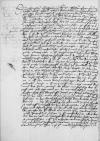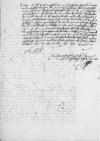Dem durchlauchten, hochgebornenn fursten und hern, hern ⌊Albrechten⌋, von Gots gnaden margraff zu ⌊Brandenburg⌋, in ⌊Prewssn⌋, zu ⌊Stetin⌋, ⌊Pomern⌋, der ⌊Cassubn⌋ und ⌊Wenden⌋ hertzog, burggraff zu ⌊Normberg⌋ und furst zu ⌊Rugen⌋, / unsern hochgunstigen, lybenn hern und freundt
Durchlauchterr, hochgebornerr furst, / hochgunstiger, freunttlicherr, lieber herrr. / Meinn freuntliche, / gancz willige unnd fleissige dienst noch al meynemm vormugen zuvorann etc.
Es hoth mir negst der edle her ⌊Achacius Czeme⌋, danczker castellan, Ewer Furstliche Durchlaucht freuntlich und hochgunstig eigen ⌊⌋ uberreicht, das ich mit sundren freuden entfangen und gelesen, / darinnen sich Ewer Furstliche Durchlaucht so vil gunstig mit offenemm gemuet gen mir entdeckt / unnd iren geneigtenn, zugethanen willenn und freuntschafft, die Ewer Furstliche Durchlaucht zu mir tregt, klerlich anczeigt, / ouch durc[h] den hern castellan entpottenn, / das ich nicht weis, / wie und wasserley gestalt ich da vor Ewer Furstliche Durchlaucht sol danckenn. / Ist ouch vil zu vil und uber al inein vordienst, das sich so gancz freuntlich / und geneigt Ewer Durchlaucht gen mir tu erbittenn und nachparlichenn haltenn wil, / wie ich ouch zuvor alwegen von Ewer Durchlaucht gespurt und befundenn. / Macht mich hiemit hoch vorpflicht / und der gestalt, / so mirs muglich, ouch mherr Ewer Furstliche Durchlaucht vorbundenn, / der zuvorsicht, das her ⌊Nibschiczen⌋ kein ursach sol gelossen werden zcwischen uns unser nachparschafft halbenn zu handlenn, / es wer dan, das er sich vor sichselbst darzu begebe. / So solten ⌊im⌋, / heth er ouch ⌊Absolonus Harr⌋ / wynnigerr, dan eynemm gancz glaczigen bleibenn. / Darzu wil ich ⌊im⌋ Ewer Durchlaucht zcedel mit den ersten schicken etc. Hie ist ouch von im ein briff an Ewer Durchlaucht, den mein diner negst von ⌊Krako⌋ mit sich gebrocht, / darin Ewer Durchlaucht wirt finden, was newes das mol bey hove gewest. Er klagt mir fast sere, das err uff sein alte tage / und gen den winterr sich zu meynemm hochgunstigen hern margraffen Jorgenn gen ⌊Prage⌋ sol vorfuegen. / Es ist im aber, / wie ich sein gemuet weis, / nicht herczlich, / dan er dem hochleblichenn ⌊Hanse Brandenburg⌋ gernn dint etc. Der froluckung, die abermals in irem schreiben so wol uff mein, alse des hern ⌊electenperson⌋ Ewer Furstliche Durchlaucht thuch, sage und schreib ich so vil danck, alse mir ummer muglich, / der gleichen der her elect ouch wirt thun. / Und wie ich nicht zcweifel, / so sich gen Ewer Durchlaucht vorhaltenn in allemm, das die dar ann sol ein wolgefallenn habenn. / Wir haben uns ouch so samptlich gen Ewer Durchlaucht zu erczeigen und wirklich zu beweisen under uns vorsprochenn, / das wir an underlass lieb und dienst zu thun Ewer Furstliche Durchlaucht wollenn schuldig seinn etc. Das Ewer Furstliche Durchlaucht irenn amptleuten wil befhelenn, sich freuntlich und nachparlich gen die meine zu haltenn, / das geschicht aus sunderer, hocher, / furstlicherr tugent, / do mit Goth derr almechtige Ewer Furstliche Durchlaucht / und mit vil andrenn tugendenn / begebt. / Der wolle die in Ewer Durchlaucht teglich sterken und mherenn / und zu langer, glukseligerr regierung, / ouch zu des leibs und der selenn seligheit lossen gereichenn, / darummb ich, wie ein grosser bussender sunder, Gothe zu bittenn nicht wil nachlassenn, demm ich Ewer Furstliche Durchlaucht mit meinerr hochgeliebten ⌊beichtochterr⌋ mit langweriger gesuntheit und alter wolfart in sein gnad und barmherczigheit / und mich in Ewer Furstliche Durchlaucht gunst thue befelenn / bittend, meinerr hochgedochten beichtochterr meine gastliche dienst und inniges gebeth anzusagen. /
Ewer Furstliche Durchlaucht
ganczvorpflichter vorbitten ⌊Ioannes⌋, colmischer bischoff, postulirt zu ⌊Ermeland⌋ scripsit


